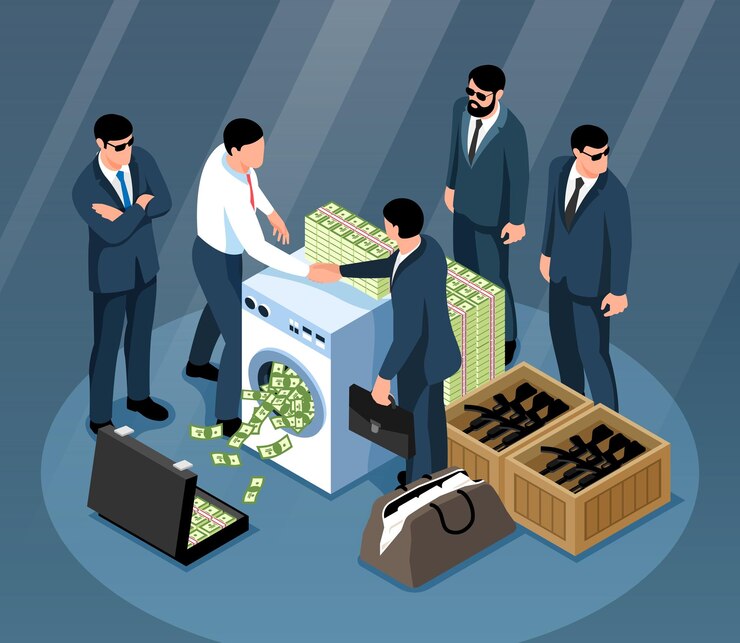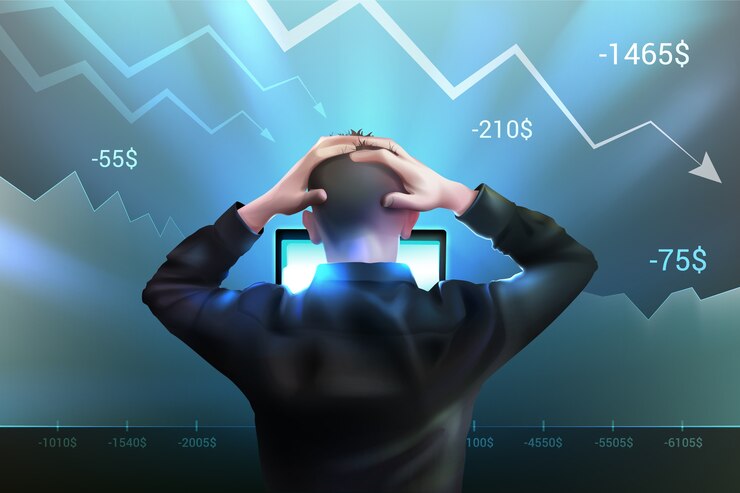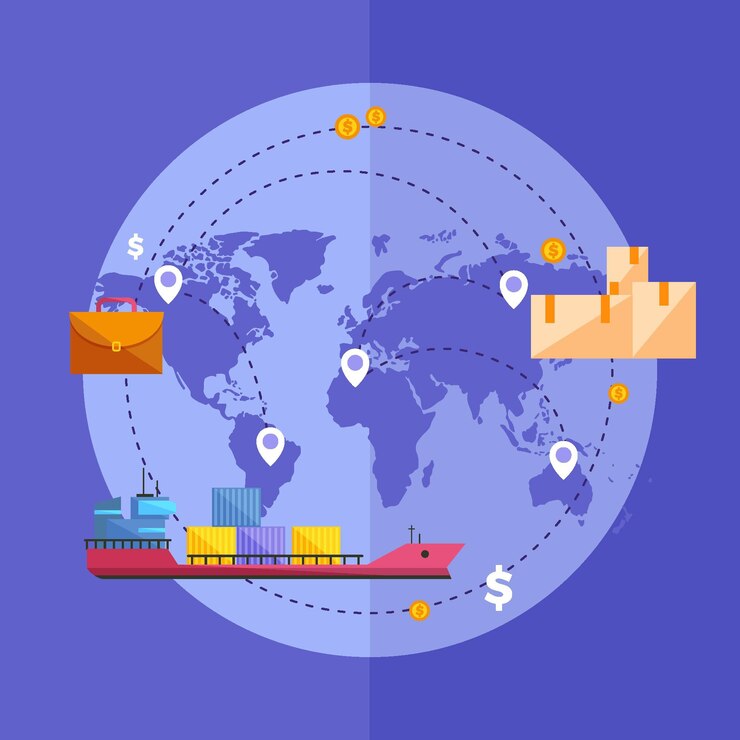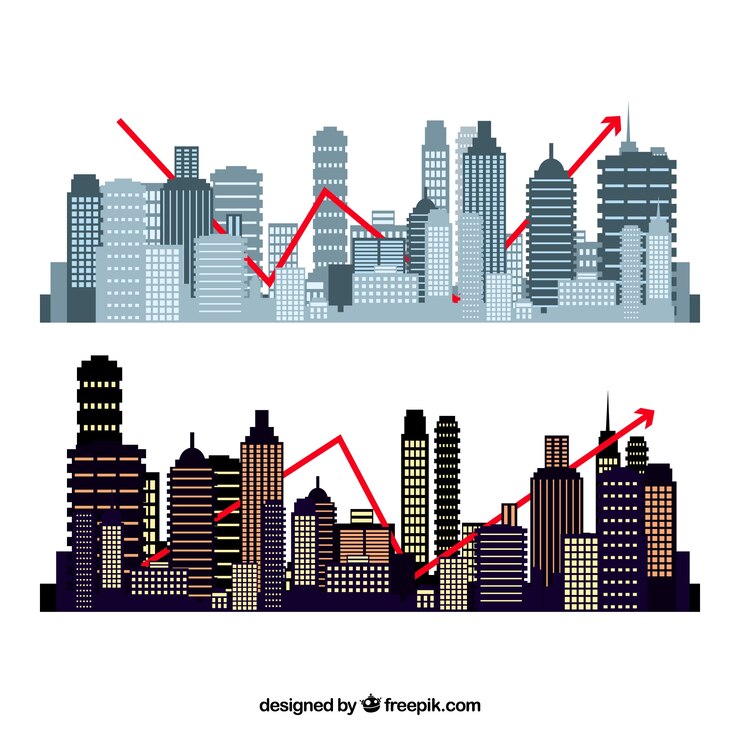Introduction
Understanding the Global Economic Crisis
The global economy is facing one of its most challenging periods in recent history. A combination of high inflation, stock market volatility, supply chain disruptions, and rising interest rates has created an environment of uncertainty for businesses, investors, and consumers alike. The aftershocks of the COVID-19 pandemic, ongoing geopolitical tensions, and monetary policy shifts by major central banks have further fueled economic instability worldwide.
As inflation soars, financial markets fluctuate, and fears of a global recession intensify, it has become more crucial than ever to analyze the economic forces shaping the world today. Understanding how inflation, stock markets, and financial trends interact will help businesses and individuals navigate these turbulent times effectively.
Why Inflation, Stock Markets, and Financial Trends Matter
Economic crises don’t happen overnight—they are the result of multiple interconnected factors that gradually build up over time. Some of the key forces influencing the current economic downturn include:
- Rising Inflation: The rapid increase in consumer prices is reducing purchasing power and straining household budgets. Essential goods such as food, fuel, and housing have become more expensive, impacting economies worldwide.
- Stock Market Volatility: Global stock markets have experienced extreme fluctuations, with major indices such as the S&P 500, NASDAQ, Dow Jones, FTSE, and Nikkei seeing sharp declines. Investor sentiment has been shaken by fears of an impending recession and aggressive interest rate hikes by central banks.
- Monetary Policies & Interest Rates: The U.S. Federal Reserve, European Central Bank (ECB), and other financial institutions are raising interest rates to combat inflation. While this helps control rising prices, it also makes borrowing more expensive, affecting businesses, mortgages, and investments.
- Supply Chain Disruptions & Geopolitical Conflicts: The war in Ukraine, economic sanctions, and logistical challenges have disrupted global supply chains, making it harder for companies to produce and distribute goods efficiently. These issues have fueled further price increases and economic instability.
Impact on Businesses and Consumers
The economic downturn has created significant challenges for businesses and individuals alike:
- For Businesses: Companies are struggling with increased production costs, labor shortages, and decreased consumer demand. Many businesses are forced to cut jobs, reduce spending, or even shut down operations to survive.
- For Investors: Market uncertainty has made traditional investments riskier, pushing many investors toward safe-haven assets like gold, bonds, and real estate. However, the volatility in stock markets continues to test investor confidence.
- For Consumers: Rising inflation means that everyday expenses—from groceries to energy bills—are becoming harder to afford. As wages struggle to keep up, households are forced to make difficult financial decisions.
What to Expect in This Article
In this in-depth analysis, we will explore:
- The root causes of the economic crisis and why inflation remains a persistent issue.
- Stock market trends and what they indicate about future financial stability.
- The impact of monetary policies, interest rate hikes, and global trade disruptions on businesses and consumers.
- Key financial trends and investment strategies that can help businesses and individuals weather the storm.
- Predictions for the future of the global economy and what lies ahead for investors and policymakers.
By understanding these critical factors, businesses and individuals can make informed financial decisions, adapt to market changes, and safeguard their wealth in uncertain times.
Let’s dive deeper into the root causes of the economic crisis and analyze the forces shaping the global financial landscape.
1. Explore the Root Causes of the Economic Crisis

The global economy is currently navigating one of its most turbulent periods, marked by high inflation, stock market instability, and financial uncertainty. But how did we get here? The economic downturn we are witnessing today is not the result of a single event—it is the outcome of multiple interconnected factors that have built up over time.
From supply chain disruptions to geopolitical tensions and central bank policies, let’s analyze the key forces that have triggered the current global financial crisis and their impact on businesses, investors, and consumers.
1. Global Supply Chain Disruptions
One of the biggest contributors to rising inflation and economic instability is the disruption of global supply chains. Since the COVID-19 pandemic, industries worldwide have struggled with delayed shipments, labor shortages, and rising transportation costs.
- Key Supply Chain Issues Affecting the Economy:
- Semiconductor Shortage: The tech and automotive industries have faced severe disruptions due to a global chip shortage, driving up prices for everything from smartphones to electric vehicles.
- Shipping Bottlenecks: Major ports have experienced congestion, leading to delays in the delivery of goods and increased logistics costs.
- Raw Material Scarcity: Essential materials like steel, aluminum, and lumber have seen significant price hikes, affecting construction, manufacturing, and infrastructure projects.
These disruptions have raised production costs for businesses, which are then passed down to consumers in the form of higher prices, fueling inflation.
2. The Role of Geopolitical Conflicts and Economic Sanctions
Geopolitical tensions have historically played a crucial role in economic recessions, and today is no different. The Russia-Ukraine war, economic sanctions, and trade restrictions have created significant financial uncertainty.
- How Geopolitical Conflicts Are Impacting the Economy:
- Energy Crisis: The war in Ukraine has led to skyrocketing oil and gas prices, increasing production and transportation costs worldwide.
- Food Supply Disruptions: Ukraine and Russia are major exporters of wheat, fertilizers, and other essential agricultural products. The war has resulted in food shortages and rising grocery prices.
- Financial Market Instability: Sanctions on Russian banks and businesses have affected global financial markets, leading to stock market volatility.
With rising political tensions between global powers, economic uncertainty remains high, and businesses and investors must brace for further instability.
3. Rising Debt Levels and Central Bank Policies
Governments and businesses around the world have accumulated record levels of debt, and as interest rates rise, this debt is becoming harder to manage.
- Why Central Bank Policies Matter:
- Post-Pandemic Stimulus Effects: During the COVID-19 crisis, central banks flooded the market with trillions of dollars in stimulus funds. While this helped prevent a recession at the time, it also contributed to higher inflation today.
- Aggressive Interest Rate Hikes: The Federal Reserve, European Central Bank (ECB), and Bank of England have aggressively increased interest rates to control inflation. However, this has made borrowing more expensive for consumers and businesses, leading to reduced spending and economic slowdowns.
- Debt Crisis in Emerging Markets: Developing countries that borrowed heavily during the pandemic are now struggling with rising debt repayments, leading to economic instability in several regions.
Central banks are stuck in a difficult balancing act—they must control inflation without triggering a deep economic recession.
4. Energy Prices and Commodity Market Volatility
The global energy crisis has played a significant role in driving up inflation rates and slowing down economic growth. The world’s dependence on oil, gas, and electricity has made it vulnerable to price shocks, which have had a domino effect across industries.
- Key Factors Driving Energy Market Instability:
- Oil and Gas Price Spikes: The war in Ukraine, production cuts by OPEC, and supply chain issues have led to rising fuel prices, affecting transportation, manufacturing, and consumer goods.
- Electricity Costs on the Rise: Many countries, particularly in Europe, have faced an energy crisis, forcing businesses and households to pay higher utility bills.
- Impact on Agriculture and Manufacturing: Rising energy prices mean higher costs for farming, transportation, and production, leading to higher food prices and increased costs for everyday goods.
As long as energy prices remain volatile, inflation will continue to be a major concern for businesses and consumers alike.
5. The Long-Term Impact of COVID-19 on Global Economies
While many countries have moved past the immediate health crisis of the COVID-19 pandemic, its economic impact is still being felt worldwide.
- How COVID-19 Reshaped the Global Economy:
- Permanent Shifts in Workforce Trends: The remote work revolution has transformed industries, reducing demand for office spaces and changing consumer spending patterns.
- Labor Shortages and Wage Inflation: Many industries are facing worker shortages, driving up wages and increasing costs for businesses.
- Economic Slowdown in China: China, one of the world’s largest economies, has faced lockdowns, production halts, and declining exports, affecting global trade.
The post-pandemic economic recovery has been uneven, with some sectors rebounding quickly while others continue to struggle.
2. Explore Inflation: The Silent Wealth Destroyer

Understanding Inflation and Its Far-Reaching Impact
Inflation is often referred to as the “silent wealth destroyer” because it gradually erodes the purchasing power of money, impacting individuals, businesses, and entire economies. When inflation rises, the cost of essential goods and services—such as food, fuel, housing, and healthcare—increases, making it harder for people to maintain their standard of living.
In the midst of the global economic crisis, inflation has emerged as one of the most pressing concerns for policymakers, investors, and consumers. Central banks worldwide, including the Federal Reserve, European Central Bank (ECB), and Bank of England, are scrambling to contain inflation through interest rate hikes and monetary tightening. However, inflation remains stubbornly high, creating financial uncertainty across global markets.
1. What is Inflation and Why is it Rising?
Inflation occurs when the overall price level of goods and services rises, reducing the purchasing power of money. This means that the same amount of money buys fewer products than before.
- Key Drivers of Inflation in the Global Economy:
A. Supply Chain Disruptions
The aftermath of the COVID-19 pandemic and ongoing geopolitical conflicts have severely disrupted global supply chains. This has led to:
- Higher transportation and shipping costs
- Shortages of essential raw materials and consumer goods
- Delays in manufacturing and production
B. Surging Energy Prices
Energy is the backbone of modern economies. Rising oil, gas, and electricity prices have led to higher costs for businesses, which are passed down to consumers. Factors contributing to energy-driven inflation include:
- The Russia-Ukraine conflict, which has disrupted global energy markets
- OPEC production cuts, reducing the supply of crude oil
- Increased demand for energy post-pandemic
C. Excessive Money Supply and Stimulus Spending
During the pandemic, governments worldwide injected trillions of dollars into their economies through stimulus programs. While this helped prevent economic collapse, it also:
- Increased consumer spending, driving demand beyond supply levels
- Fueled asset bubbles in stocks, real estate, and cryptocurrencies
- Led to currency devaluation, making imported goods more expensive
D. Wage Growth and Labor Shortages
The Great Resignation and post-pandemic labor shortages have driven wages higher. While higher wages help workers keep up with inflation, they also:
- Increase business costs, leading to higher product prices
- Contribute to wage-price spirals, where rising wages fuel further inflation
2. The Impact of Inflation on Businesses and Consumers
Inflation has a domino effect across the entire economy, affecting everyone from corporations to households.
- How Inflation Hurts Businesses:
- Higher production costs due to rising raw material and energy prices
- Supply chain disruptions leading to inventory shortages and delays
- Reduced consumer spending, as people prioritize essential expenses over discretionary purchases
- Increased borrowing costs, making it harder for businesses to expand
ii How Inflation Affects Consumers:
- Rising food prices make everyday groceries more expensive
- Higher rent and mortgage rates put pressure on household budgets
- Increased interest rates make credit cards and loans more costly
- Declining savings value, as inflation erodes the real worth of money sitting in bank accounts
When inflation rises faster than wage growth, consumers experience a cost-of-living crisis, leading to reduced spending and lower economic growth.
3. The Role of Central Banks: Can They Control Inflation?
To combat inflation, central banks have been aggressively raising interest rates to slow down excessive spending and borrowing. But this strategy comes with risks.
- How Interest Rate Hikes Affect the Economy:
- Higher borrowing costs slow down real estate, business investments, and consumer loans
Stock market volatility, as investors shift funds from equities to safer assets
- Recession risks, as aggressive monetary tightening can trigger economic slowdowns
The Federal Reserve and other central banks are in a tough balancing act—raising interest rates too much could cause a recession, but not doing enough could allow inflation to spiral out of control.
4. Hyperinflation vs. Stagflation: Worst-Case Scenarios
If inflation remains unchecked, it can lead to economic disasters such as:
- Hyperinflation: When prices rise at an uncontrollable rate, leading to currency collapse (e.g., Zimbabwe, Venezuela)
- Stagflation: A dangerous mix of high inflation and stagnant economic growth, making recovery extremely difficult (e.g., 1970s U.S. economy)
With global economies teetering on the edge, policymakers must act strategically to prevent these worst-case economic scenarios from unfolding.
5. How to Protect Your Finances Against Inflation
In times of economic crisis, individuals and businesses must adopt smart financial strategies to mitigate the effects of inflation.
- Smart Strategies for Consumers:
- Invest in inflation-resistant assets like gold, real estate, and commodities
- Cut unnecessary expenses and focus on essential spending
- Increase income streams through side businesses, freelancing, or upskilling
- Reduce debt, as rising interest rates make loans more expensive
- Investment Tips for Businesses and Investors:
Diversify portfolios with inflation-hedge assets like Treasury Inflation-Protected Securities (TIPS)
- Monitor central bank policies and adjust financial strategies accordingly
- Focus on value stocks and dividend-paying companies that perform well during inflationary periods
- Avoid excessive leverage and high-risk investments during uncertain economic conditions.
3. Explore Stock Markets: A Rollercoaster of Uncertainty

The global stock markets have been on a wild ride, reflecting the ongoing economic crisis fueled by inflation, rising interest rates, geopolitical tensions, and financial instability. Investors have witnessed extreme market volatility, with major indices swinging between sharp gains and steep declines.
From the Wall Street sell-offs to cryptocurrency crashes, financial markets are experiencing unprecedented uncertainty. The combination of economic downturns, corporate earnings pressures, and central bank policies has left investors questioning where to put their money in such turbulent times.
1. Why Are Stock Markets in Crisis?
The stock market downturn we are witnessing today is driven by multiple factors, each contributing to investor panic and economic uncertainty.
Key Drivers of Stock Market Volatility:
A. Inflation and Interest Rate Hikes
- High inflation erodes company profits and reduces consumer spending.
- Central bank policies (such as the Federal Reserve’s aggressive rate hikes) increase borrowing costs, making corporate expansion and investments more expensive.
- Higher interest rates make safer assets (like bonds) more attractive, leading investors to pull out of stocks.
B. Fear of a Global Recession
- Economists warn that monetary tightening could push the global economy into a recession.
- Businesses are already reporting declining earnings, causing stock prices to drop.
- Investors fear that a prolonged economic slowdown could trigger mass layoffs, reduced corporate spending, and lower GDP growth.
C. Geopolitical Uncertainty and Trade Wars
- The Russia-Ukraine conflict, U.S.-China trade tensions, and global supply chain disruptions have created instability in stock markets.
Sanctions and tariffs impact multinational corporations, leading to reduced investor confidence.
- Energy price volatility has affected industries like aviation, manufacturing, and logistics, making stocks in these sectors riskier.
D. Tech Stocks and the Cryptocurrency Crash
- Tech giants that once led the market boom are now facing massive sell-offs due to weaker revenue growth and rising borrowing costs.
- The crypto market collapse, triggered by regulatory crackdowns, fraud scandals, and speculative bubbles bursting, has wiped out billions in investor wealth.
- The fall of major crypto firms like FTX and Terra Luna has further shaken investor confidence.
2. How Are Different Sectors Performing?
While all major stock indices (such as the S&P 500, NASDAQ, Dow Jones, FTSE 100, and Nikkei 225) have seen declines, not all sectors are equally affected.
Winners vs. Losers in the Stock Market Crisis:
- Sectors Hit Hard by the Stock Market Slump
- Technology Stocks – Companies like Meta, Amazon, and Tesla have seen massive sell-offs due to rising interest rates and slowing growth.
- Consumer Discretionary Stocks – Retail, travel, and luxury brands are struggling as consumers cut back on spending.
- Real Estate – Rising mortgage rates have slowed down property markets, leading to a drop in real estate stocks.
Cryptocurrencies – Bitcoin, Ethereum, and other digital assets have lost over 50% of their value due to market panic and liquidity issues.
- Sectors Resilient in Market Uncertainty
- Energy Stocks – Oil and gas companies have surged as energy prices remain volatile.
- Defensive Stocks – Sectors like healthcare, utilities, and consumer staples tend to perform well during economic downturns.
- Dividend Stocks – Investors are shifting toward companies that provide stable dividends for steady income.
- Gold and Precious Metals – Historically, gold is seen as a safe-haven asset during market turmoil.
3. Bear Market vs. Bull Market: Where Are We Headed?
Are We in a Bear Market?
A bear market occurs when stock indices fall 20% or more from their recent highs.
Many analysts believe that the current market conditions reflect a prolonged bear market due to the combination of inflation, rising interest rates, and slowing economic growth.
Will We See a Bull Market Soon?
- Bull markets thrive when there is economic recovery, strong corporate earnings, and investor confidence.
- Some investors believe that if inflation slows down and interest rates stabilize, the market could begin a gradual recovery.
For now, market sentiment remains cautious, with investors closely watching Federal Reserve decisions, corporate earnings reports, and global geopolitical developments.
4. Stock Market Strategies for Investors in a Crisis
In times of stock market uncertainty, investors need to adjust their strategies to protect their portfolios and minimize risk.
- Smart Investment Strategies During Market Volatility:
- Diversify Your Portfolio – Spread investments across multiple sectors, including defensive stocks, commodities, and bonds.
- Invest in Dividend Stocks – Companies that offer consistent dividends can provide a source of income even during market downturns.
- Consider Value Investing – Stocks with strong fundamentals and low valuations are attractive during bear markets.
- Avoid High-Risk Speculative Assets – Cryptocurrency, unproven tech startups, and leveraged investments can be extremely volatile.
- Keep a Long-Term Perspective – Market downturns are temporary. Historically, the stock market has always rebounded over time.
While short-term market trends may be unpredictable, investors who focus on long-term wealth-building strategies can navigate economic downturns successfully.
5. What’s Next for Global Stock Markets?
- Stock Market Predictions for the Future:
- Short-Term Outlook: Continued volatility as central banks fight inflation and fears of a recession persist.
- Medium-Term Recovery: If inflation stabilizes and interest rates level off, markets could regain momentum.
- Long-Term Growth: Historically, stock markets recover from crises and reach new highs, rewarding patient investors.
While uncertainty remains high, history has shown that stock markets are resilient and eventually rebound. However, investors must remain informed, adaptable, and strategic in their financial decisions
4. Explore Interest Rate Hikes and Monetary Policies

The global economy is at a crossroads, with interest rate hikes and monetary policies playing a crucial role in shaping financial stability. As central banks scramble to control inflation, their aggressive stance on raising interest rates has sparked fears of a recession, stock market downturns, and rising debt burdens.
From the U.S. Federal Reserve to the European Central Bank (ECB) and the Bank of England, policymakers are using monetary tightening as a weapon to combat inflation. But will these strategies restore economic balance, or will they trigger a deeper financial crisis?
1. Why Are Central Banks Raising Interest Rates?
The Battle Against Inflation
- Inflation has soared to its highest levels in decades, eroding the purchasing power of consumers.
- To slow inflation, central banks increase interest rates, making borrowing more expensive and reducing excessive spending.
By tightening monetary policy, central banks hope to stabilize prices and bring inflation under control.
Key Central Bank Actions:
- U.S. Federal Reserve – Aggressive rate hikes, pushing borrowing costs to multi-year highs.
- European Central Bank (ECB) – Raising interest rates to combat eurozone inflation.
- Bank of England (BoE) – Fighting inflation amid economic slowdown concerns.
- Reserve Bank of India (RBI) – Adjusting rates to balance growth and inflation control.
While these measures aim to reduce inflation, they also come with risks—slower economic growth, higher debt burdens, and stock market volatility.
2. How Do Interest Rate Hikes Impact Businesses and Consumers?
- The Ripple Effect on Consumers
- Higher mortgage rates – Home loan costs rise, making housing less affordable.
- Expensive credit card debt – Interest rates on consumer loans increase, limiting spending power.
- Lower disposable income – Households cut back on non-essential expenses, slowing down economic activity.
- Impact on Businesses and Investments
- Rising borrowing costs – Companies struggle with higher debt repayments.
- Reduced corporate investments – Businesses delay expansion plans, leading to slower growth.
- Stock market volatility – Investors react to interest rate hikes by shifting funds from equities to safer assets like bonds.
When interest rates rise too quickly, it can trigger a recession, forcing businesses to cut jobs, reduce spending, and struggle with profitability.
3. Global Debt Crisis: Are Higher Interest Rates Making It Worse?
Debt Burden on Governments and Corporations
- Countries with high debt levels (like the U.S., Japan, and emerging markets) are now facing higher interest payments on their national debts.
- Many corporations that relied on cheap loans are now struggling with debt repayments, increasing the risk of defaults and bankruptcies.
- Emerging Market Risks
- Developing economies that borrowed in U.S. dollars are suffering as rising rates make their debt repayments more expensive.
- Countries like Argentina, Turkey, and Sri Lanka are facing currency devaluation and economic instability.
With global debt at record levels, higher interest rates could push some economies into financial crises, leading to currency collapses, banking failures, and mass layoffs.
4. The Dilemma: Inflation Control vs. Economic Growth
- The Central Bank Balancing Act
Central banks are caught in a tough position—
- If they raise rates too aggressively, they risk causing a recession, job losses, and economic downturns.
- If they don’t raise rates enough, inflation could spiral out of control, leading to a cost-of-living crisis.
- Possible Scenarios Moving Forward:
- Soft Landing – Central banks successfully control inflation without triggering a recession.
- Hard Landing – Aggressive rate hikes lead to a full-blown recession.
- Stagflation – A worst-case scenario where high inflation and stagnant growth exist simultaneously.
With uncertainty looming, businesses and investors are closely watching how central banks navigate this crisis.
5. Investment and Financial Strategies in a High-Interest Environment
- Smart Moves for Businesses and Investors:
- Invest in defensive sectors – Healthcare, utilities, and consumer staples tend to perform well during economic slowdowns.
- Avoid excessive debt – Businesses and individuals should minimize borrowing at high-interest rates.
- Focus on cash-flow investments – Dividend-paying stocks and rental properties can provide steady income.
- Monitor central bank policies – Stay updated on interest rate decisions to adjust financial strategies accordingly.
For investors, adapting to changing monetary policies is key to navigating market uncertainty and safeguarding wealth.
5. Explore Global Trade and Supply Chain Disruptions

The global economy is facing an unprecedented crisis, with supply chain disruptions and trade imbalances adding another layer of complexity. The pandemic, geopolitical conflicts, inflation, and rising interest rates have exposed vulnerabilities in the global supply chain, disrupting industries, increasing costs, and delaying production worldwide.
From semiconductor shortages affecting the tech industry to shipping bottlenecks raising consumer prices, the impact is being felt across all sectors. Businesses are now forced to rethink their supply chain strategies, while governments look for ways to secure critical resources and stabilize global trade.
1. How Did Global Supply Chains Get So Disrupted?
- Key Factors Behind the Supply Chain Crisis:
A. The Aftermath of the COVID-19 Pandemic
- Factory shutdowns in China and other manufacturing hubs led to production delays.
- Labor shortages across industries slowed down manufacturing, transportation, and logistics.
Ports and shipping delays created bottlenecks, increasing freight costs and delivery times.
B. Geopolitical Tensions and Trade Wars
- The Russia-Ukraine war disrupted energy and agricultural exports, leading to food and fuel price spikes.
- U.S.-China trade tensions led to increased tariffs, affecting global commerce and manufacturing costs.
- Nations are shifting towards “friendshoring” (prioritizing trade with allied countries), further altering supply chains.
C. Energy Price Volatility and Raw Material Shortages
- Rising oil and gas prices have increased transportation and production costs.
- Shortages of key raw materials (such as lithium for EV batteries and microchips for electronics) have affected industries from tech to automotive.
- Climate change and natural disasters (like droughts and hurricanes) have disrupted agricultural production, leading to food shortages.
The combination of these factors has created a perfect storm for supply chains, leading to rising inflation, production delays, and higher consumer costs.
2. The Impact on Businesses and Consumers
- How Are Businesses Coping?
- Manufacturers are diversifying suppliers – Companies are reducing reliance on a single country (especially China) by sourcing from multiple regions.
- Warehousing and inventory strategies are changing – Businesses are shifting from “just-in-time” to “just-in-case” inventory models to avoid shortages.
- Automation and nearshoring are on the rise – Companies are investing in robotics and moving production closer to home to reduce dependency on long supply chains.
- How Are Consumers Affected?
- Higher prices on essential goods – Inflationary pressures from supply shortages have made everyday products more expensive.
- Longer wait times for products – Items like cars, electronics, and home appliances have faced significant delivery delays.
- Limited product availability – Shortages in semiconductors, food, and pharmaceuticals have led to fewer choices for consumers.
As supply chains remain unstable, businesses and consumers must adapt to an era of higher costs, shifting trade dynamics, and unpredictable disruptions.
3. The Role of Global Trade in Economic Recovery
- Can Trade Policies Help Stabilize the Global Economy?
- Nations are renegotiating trade agreements to secure critical goods and reduce dependency on adversarial countries.
- Supply chain resilience is a priority for businesses and governments investing in alternative sourcing and domestic production.
- Global trade organizations (like the WTO) are pushing for cooperative solutions to minimize disruptions.
- Future Trade Strategies:
- Reshoring & Nearshoring – Companies bringing production closer to home (e.g., U.S. companies investing in Mexico rather than China).
- Digital Supply Chains – AI and blockchain are being used to improve logistics transparency and efficiency.
- Green Supply Chains – Companies are focusing on sustainability, reducing carbon footprints in transportation and manufacturing.
While global trade faces immense challenges, innovation, policy shifts, and strategic planning will help businesses navigate this crisis.
4. What’s Next for Global Supply Chains?
Key Predictions for the Future:
- Short-Term: Continued disruptions, high shipping costs, and inflationary pressures.
- Medium-Term: Businesses will adopt new supply chain strategies, focusing on diversification and automation.
- Long-Term: Resilient, tech-driven, and sustainable supply chains will redefine global trade.
Governments, businesses, and consumers must adapt to the new realities of global commerce and financial trends. The path forward will depend on how quickly supply chain networks can adjust to changing economic and geopolitical landscapes.
6. Explore The Job Market and Wage Growth Trends

The global economy is facing an era of rapid transformation, and one of the most pressing concerns is the job market and wage growth trends. As businesses adapt to inflation, rising interest rates, and supply chain disruptions, employees are feeling the ripple effects in the form of job insecurity, stagnant wages, and shifting employment patterns.
The pandemic reshaped the workforce, with trends like remote work, automation, and the gig economy redefining traditional employment. Now, as central banks fight inflation with aggressive interest rate hikes, businesses are tightening budgets, slowing hiring, and even resorting to mass layoffs in some industries. But on the other hand, certain sectors are experiencing strong wage growth and labor shortages, creating an uneven job market.
1. The Post-Pandemic Job Market: Recovery or Recession?
Unemployment and Job Cuts on the Rise
- Tech industry layoffs – Major companies like Meta, Amazon, and Google have slashed thousands of jobs.
- Financial sector downsizing – Rising interest rates have slowed investment, leading to job losses in banking and real estate.
- Retail and e-commerce struggles – With consumer spending slowing, many retailers have cut jobs and store locations.
- Labor Shortages in Key Industries
- Healthcare and education – A shortage of doctors, nurses, and teachers is pushing wages higher.
- Skilled trades and construction – Infrastructure projects are booming, but a lack of skilled workers is driving up pay.
- Hospitality and service industries – Many workers left during the pandemic, and businesses are struggling to fill positions.
This imbalance means that while some industries struggle with layoffs, others are desperate for talent—creating a fragmented job market.
2. Wage Growth vs. Inflation: Are Salaries Keeping Up?
Rising Wages, But Losing Purchasing Power
- While wages are increasing in many industries, inflation is rising even faster, meaning real income is declining.
- Employees are demanding higher salaries and cost-of-living adjustments, leading to more union strikes and labor disputes.
- Companies are trying to balance profitability and employee retention, with some offering bonuses instead of permanent raises.
Sectors with the Highest Wage Growth:
- Technology and AI – Skilled professionals in AI and cybersecurity are seeing record salaries.
- Healthcare and pharmaceuticals – High demand for medical professionals is pushing wages up.
- Green energy and sustainability – The push for renewable energy is creating well-paid jobs in engineering and tech.
On the flip side, industries like retail, hospitality, and clerical jobs are seeing slower wage growth, making it harder for workers to keep up with the cost of living.
3. The Future of Work: Remote Jobs, AI, and Automation
Remote Work and Hybrid Models Are Here to Stay
- Many companies are adopting hybrid work policies, balancing office time with remote flexibility.
- Employees prefer remote jobs, leading to competition for fully remote roles.
- Businesses are investing in digital collaboration tools, reshaping the way teams work.
Automation and AI Are Replacing Traditional Jobs
- AI and robotics are eliminating repetitive tasks in manufacturing, retail, and customer service.
- Chatbots and AI tools are replacing entry-level jobs in tech and business services.
- Companies are reskilling employees to adapt to new digital and AI-driven roles.
While automation threatens some jobs, it is also creating new opportunities for workers with tech skills, problem-solving abilities, and adaptability.
4. The Gig Economy and Freelance Boom
Freelancing is on the Rise
- Many professionals are leaving traditional jobs for freelance work and side hustles.
- Platforms like Upwork and Fiverr have made it easier for workers to find flexible, high-paying gigs.
- Digital nomadism is growing, with workers choosing to live abroad while freelancing remotely.
Challenges in the Gig Economy
- Lack of job security – No benefits, healthcare, or retirement plans.
- Inconsistent income – Pay rates can fluctuate, making financial planning difficult.
- Regulatory uncertainty – Governments are debating whether gig workers should have employee protections.
While the gig economy offers freedom and flexibility, it also presents financial risks for workers who lack traditional employment benefits.
5. What’s Next for the Global Job Market?
Key Predictions for the Future:
- Tech and AI jobs will continue to grow, while traditional roles may decline.
- Remote work and hybrid models will remain popular, but some companies will push for return-to-office policies.
- Labor shortages will drive up wages in healthcare, skilled trades, and energy sectors.
- Automation will reshape industries, making upskilling and digital literacy essential.
- Governments may introduce policies to regulate the gig economy and protect freelance workers.
The job market is evolving rapidly, and both employers and employees must adapt to new financial trends, economic shifts, and technological advancements.
7. Explore The Housing Market: Boom or Bust?

The global economy is at a crossroads, and one of the biggest questions on everyone’s mind is: Will the housing market boom or collapse?
Over the past few years, real estate markets worldwide have experienced record-breaking price increases, bidding wars, and soaring mortgage rates. But as inflation, interest rate hikes, and economic uncertainty continue to shake financial markets, the housing sector is showing signs of a slowdown.
Some experts predict a housing market crash, while others believe the market is correcting itself after years of unsustainable growth. So, what’s really happening? And more importantly, what does this mean for homebuyers, investors, and renters?
1. The Housing Market Surge: How Did We Get Here?
Why Did Housing Prices Skyrocket?
- Low interest rates (2020-2022) – Central banks slashed interest rates to stimulate the economy, making mortgages cheaper and fueling a buying frenzy.
Housing supply shortages – Years of underbuilding and supply chain disruptions created a housing shortage, driving up demand.
- Investors and institutional buyers – Hedge funds, private equity firms, and real estate investors poured money into housing, outbidding regular buyers.
- The pandemic-driven migration – Remote work allowed people to move to suburban and rural areas, increasing demand in previously overlooked markets.
These factors led to an unsustainable housing boom, with home prices reaching record highs in many countries.
2. The Interest Rate Shock: Cooling Down the Housing Market
How Interest Rate Hikes Are Affecting Housing
- Mortgage rates have doubled in many countries, making homeownership more expensive.
- Buyers are priced out, leading to fewer home sales and increasing inventory.
Home values are declining in some overheated markets, raising fears of a potential crash.
Examples of Housing Market Slowdowns:
- United States – Home sales have dropped significantly, and prices are falling in expensive markets like San Francisco and Seattle.
- United Kingdom – Mortgage approvals have plunged as higher interest rates make borrowing more expensive.
- Canada – Once red-hot cities like Toronto and Vancouver are seeing price corrections.
- China – A real estate crisis has emerged, with major property developers facing financial instability.
While the housing market is slowing down, it is not yet collapsing—but risks remain.
3. Is a Housing Market Crash Coming?
Potential Signs of a Housing Crash
- Rising foreclosures – As mortgage rates rise and inflation squeezes household budgets, more homeowners may struggle to keep up with payments.
- Overleveraged investors – Many property investors took on cheap debt to buy multiple homes, and higher rates could force them to sell.
- Economic recession fears – If the economy weakens, job losses could trigger more mortgage defaults.
Why a Crash Might NOT Happen
- Housing supply is still limited – Many markets still have a shortage of homes, preventing a drastic price collapse.
- Stricter lending standards – Unlike the 2008 financial crisis, banks have been more cautious about lending, reducing the risk of a mortgage meltdown.
- Strong rental demand – As homeownership becomes less affordable, more people are renting, keeping real estate investments profitable.
Rather than a full-blown crash, the housing market is likely experiencing a correction, where prices stabilize after years of excessive growth.
4. The Rental Market: Soaring Prices and Affordability Challenges
Why Are Rents Rising?
- More people are renting as homeownership becomes less affordable.
- Limited rental supply is driving competition, pushing prices higher.
- Institutional investors are buying rental properties, leading to corporate-controlled housing markets.
Rental Market Trends:
- Big cities are seeing rent spikes as people return after the pandemic.
- Suburban and secondary markets are experiencing growing demand.
- Rent control policies are being debated as affordability concerns rise.
For renters, affordability remains a serious challenge, especially in major cities where wages are not keeping up with rent increases.
5. The Future of the Housing Market: What Comes Next?
Key Predictions for the Housing Market:
- Mortgage rates will remain high, keeping homeownership expensive.
- Home price growth will slow down, but a full crash is unlikely.
- Rents will continue to rise, making renting less affordable.
- Government policies may intervene, such as tax breaks for first-time buyers or rent control measures.
- A shift to multi-generational housing may emerge as families combine resources to afford homes.
Investors, homeowners, and renters must prepare for a changing real estate landscape as financial trends reshape the market.
8. Explore Key Financial Trends and Investment Strategies

The global economy is in a state of flux, with rising inflation, interest rate hikes, stock market volatility, and geopolitical tensions reshaping financial markets. For investors, the challenge is clear: How do you protect wealth and identify opportunities in an uncertain economic environment?
Whether you’re a seasoned investor or just starting out, understanding key financial trends and smart investment strategies is essential to navigate market uncertainty and maximize returns
1. Key Financial Trends Shaping the Global Economy
Economic Uncertainty and Market Volatility
- Global recession fears – Slower economic growth and high inflation continue to create uncertainty.
- Stock market fluctuations – Major indices like the S&P 500, NASDAQ, and Dow Jones remain volatile.
- Geopolitical instability – Trade tensions, war risks, and global supply chain disruptions are affecting financial markets.
Inflation and Interest Rate Pressures
- Persistent inflation – Despite central bank efforts, inflation remains stubbornly high in many economies.
- Aggressive interest rate hikes – The Federal Reserve, European Central Bank, and others have raised rates to control inflation.
- Higher borrowing costs – Businesses and consumers face higher mortgage rates, loan costs, and credit card interest.
Shift in Investment Patterns
- Investors are moving away from high-risk stocks and into safe-haven assets like gold and treasury bonds.
- Emerging markets and commodities are attracting interest as alternatives to traditional investments.
- ESG (Environmental, Social, and Governance) investing is gaining traction as sustainability becomes a priority.
These trends signal a transformation in how businesses, consumers, and investors manage their financial decisions in a rapidly changing world.
2. Smart Investment Strategies for Uncertain Times
Given the unpredictable economic landscape, investors must adopt flexible and defensive strategies to protect wealth while capitalizing on market opportunities.
1. Diversification: The Key to Risk Management
- Spread investments across multiple asset classes – Stocks, bonds, real estate, commodities, and cash.
- Avoid overexposure to one sector – Tech stocks, for example, were high-flyers but have seen major corrections.
- Consider global investments – International stocks and ETFs can provide exposure to high-growth markets.
2. Focus on Defensive Stocks and Value Investing
- Look for companies with strong balance sheets, consistent cash flow, and low debt.
- Defensive sectors like healthcare, consumer staples, and utilities tend to perform well during downturns.
- Dividend-paying stocks provide steady income and tend to be more stable.
3. Real Estate as a Long-Term Hedge Against Inflation
- Housing market slowdowns are creating opportunities to buy undervalued properties.
- Rental properties remain attractive due to increasing housing demand.
- Commercial real estate may be risky due to the shift toward remote work.
4. Alternative Investments: Gold, Crypto, and Commodities
- Gold remains a top safe-haven asset during economic uncertainty.
- Cryptocurrencies like Bitcoin and Ethereum offer high-risk, high-reward opportunities but remain volatile.
- Commodities like oil, natural gas, and agricultural products can hedge against inflation.
5. Embracing Technology and Innovation Investments
- AI, blockchain, and green energy are emerging sectors with long-term growth potential.
- Tech stocks have dipped but may present buying opportunities for long-term investors.
- Cybersecurity and cloud computing continue to be high-growth industries.
By balancing risk with strategic asset allocation, investors can weather economic turbulence while positioning themselves for long-term financial success.
3. Key Takeaways: How to Invest Wisely in 2024
Actionable Investment Tips:
- Stay diversified – Don’t put all your money into one asset class or industry.
- Focus on defensive investments – Prioritize dividend stocks, bonds, and recession-proof sectors.
- Be cautious with high-risk assets – Crypto and speculative stocks can be rewarding but also highly volatile.
- Consider real estate strategically – Look for opportunities in markets where prices are stabilizing.
- Keep an eye on global trends – Economic shifts in China, Europe, and emerging markets will impact global investments.
- Adapt to new financial realities – The traditional “buy-and-hold” strategy may need adjustments in a fast-changing economy.
9. Explore Government Policies and Fiscal Measures

As the global economy faces mounting challenges—inflation, recession fears, stock market volatility, and financial instability—governments worldwide are implementing fiscal policies and monetary strategies to stabilize economies, protect businesses, and safeguard consumer purchasing power.
But are these government policies enough to combat economic uncertainty? Or will they create long-term financial risks, higher debt levels, and sluggish growth?
1. Government Response to Economic Crises
Why Governments Intervene in the Economy
When economies weaken due to inflation, stock market crashes, or financial instability, governments take action to stimulate growth, protect jobs, and ensure financial stability.
Key strategies include:
- Monetary policy tools – Adjusting interest rates and controlling money supply.
- Fiscal stimulus measures – Increasing government spending and cutting taxes.
- Regulatory interventions – Strengthening financial regulations to prevent banking collapses.
Major Government Interventions in Recent Years
- COVID-19 Stimulus Packages – Trillions of dollars were injected into global economies to prevent collapse.
- Central Bank Interest Rate Hikes – The Federal Reserve, European Central Bank, and Bank of England have aggressively raised rates to fight inflation.
- Energy Price Subsidies – Many European governments introduced price caps on electricity and gas to counter rising energy costs.
- Banking Sector Bailouts – Governments have stepped in to stabilize financial institutions amid market crashes.
These interventions play a crucial role in steering economies through crises, but they also come with risks—such as higher national debt, inflationary pressures, and long-term economic imbalances.
2. The Role of Monetary Policy: Interest Rates and Inflation Control
How Central Banks Manage the Economy
Monetary policy is one of the most powerful economic tools controlled by central banks like the Federal Reserve (U.S.), the European Central Bank (ECB), and the Bank of Japan.
Key Monetary Policy Tools:
- Interest Rate Hikes – Raising rates to curb inflation and cool down overheated economies.
- Quantitative Tightening (QT) – Reducing money supply to control excess liquidity.
- Foreign Exchange Interventions – Stabilizing currency fluctuations to prevent economic shocks.
Recent Central Bank Moves:
- The Federal Reserve raised interest rates to their highest levels in over 20 years to combat inflation.
- The European Central Bank adopted a more aggressive tightening strategy amid energy-driven price hikes.
- Emerging market economies are struggling as high interest rates in developed countries attract global capital away from them.
While higher interest rates help curb inflation, they also slow economic growth and increase borrowing costs for businesses and consumers, leading to lower investments, job cuts, and housing market slowdowns.
3. Fiscal Policies: Government Spending and Taxation Strategies
How Governments Use Fiscal Policies to Stabilize Economies
Unlike monetary policies, which are controlled by central banks, fiscal policies are set by national governments.
Key Fiscal Measures in Action:
- Government Stimulus Packages – Direct cash payments, business relief funds, and infrastructure spending.
- Corporate and Individual Tax Cuts – Reducing taxes to boost disposable income and business growth.
- Public Sector Investments – Spending on healthcare, technology, and green energy to drive economic recovery.
Case Studies of Fiscal Interventions:
- United States: The Inflation Reduction Act aims to tackle inflation while promoting green energy investments.
- European Union: Countries like Germany and France are increasing social spending to support citizens against rising living costs.
- China: The government is injecting liquidity into financial markets to stabilize economic growth.
While fiscal stimulus helps short-term economic recovery, excessive government spending can lead to rising national debt, higher inflation, and long-term financial instability.
4. The Debate: Are Government Policies Helping or Hurting?
Potential Risks of Over-Intervention
- High national debt levels – Many governments are borrowing heavily, leading to future financial burdens.
- Inefficiencies in stimulus spending – Some government programs have poor execution, corruption, or wasteful spending.
- Market distortions – Artificially low interest rates and excessive government spending can create financial bubbles.
Why Government Policies Are Still Essential
- Preventing deep recessions – Without intervention, many economies could experience severe downturns.
- Protecting jobs and businesses – Stimulus measures help prevent widespread layoffs and bankruptcies.
- Long-term investments in critical sectors – Funding for infrastructure, healthcare, and innovation drives future growth.
The key challenge for policymakers is finding the right balance between economic stability and long-term sustainability.
5. What’s Next? The Future of Government Economic Policies
Predictions for Fiscal and Monetary Policies in 2024 and Beyond
- Interest rates may remain high as central banks continue to fight inflation.
- Governments may introduce more tax incentives to stimulate business growth.
- Debt crises may emerge in heavily indebted economies, leading to tighter spending controls.
- New regulations on financial markets could reshape global investment strategies.
- Green energy investments and digital economy initiatives will drive government funding priorities.
As global economies adapt to shifting financial landscapes, government policies will continue to play a crucial role in determining economic stability, business growth, and investment opportunities.
10. Explore The Future of the Global Economy

The global economy is at a crossroads. After facing relentless challenges like high inflation, rising interest rates, stock market volatility, and geopolitical instability, governments, businesses, and investors are now looking ahead to what the future holds. Will we see a recession, a slow recovery, or a new era of economic expansion?
1. Key Economic Forecasts for the Next Decade
Will the World Enter a Prolonged Recession?
- Many economists predict a mild to moderate global recession due to aggressive interest rate hikes and slowing consumer demand.
- The U.S. Federal Reserve, European Central Bank, and Bank of England continue to maintain higher interest rates to curb inflation, which may slow economic growth.
- Emerging markets could face financial distress as global capital shifts towards safer assets.
Inflation: A Lingering Threat or Temporary Issue?
- Inflation rates have started to cool in some economies, but rising energy prices, wage pressures, and supply chain issues could keep inflation higher than pre-pandemic levels.
- Governments may continue to intervene with fiscal policies to ease inflation’s impact, but excessive spending could lead to higher national debt.
Technological Innovations Driving Economic Growth
- Artificial Intelligence (AI), automation, blockchain, and green energy are expected to fuel new economic expansion.
- Businesses that embrace digital transformation and sustainable development will likely outperform competitors.
- The shift toward renewable energy will create multi-trillion-dollar investment opportunities in solar, wind, and electric vehicles (EVs).
2. Emerging Trends Shaping the Future of Financial Markets
Stock Market Trends: Will Volatility Continue?
- Stock markets will remain volatile as central banks adjust interest rates and economic growth slows.
- Tech stocks may rebound as innovation in AI, cloud computing, and cybersecurity drives demand.
- Dividend stocks and defensive sectors (healthcare, consumer goods, and utilities) will remain strong investment choices.
The Shift Toward Alternative Investments
- Gold and commodities will continue to be a hedge against inflation and economic instability.
- Cryptocurrency markets are recovering after a turbulent 2022-2023, with Bitcoin and Ethereum gaining momentum.
- Private equity and venture capital investments will focus on high-growth sectors like AI, biotech, and clean energy.
The Changing Role of Global Currencies
- The U.S. dollar remains dominant, but de-dollarization efforts by China, Russia, and BRICS nations could reshape global trade.
- Central Bank Digital Currencies (CBDCs) could revolutionize the financial system, making transactions faster and more secure.
3. The Future of Global Trade and Economic Power Shifts
Will Globalization Continue or Decline?
- Supply chain disruptions and geopolitical tensions have forced many countries to rethink their reliance on foreign imports.
- Nearshoring and reshoring (bringing manufacturing closer to home) are increasing, especially in the U.S. and Europe.
- China’s economic slowdown is raising questions about the future of its dominance in global trade.
The Rise of Emerging Markets
- India, Southeast Asia, and Africa are expected to be the next major growth hubs due to young populations and expanding digital economies.
- Latin America’s natural resources (lithium, oil, and rare earth minerals) are gaining strategic importance.
- The Gulf region is investing heavily in tech and infrastructure to diversify beyond oil.
Economic Power Shifts: The U.S. vs. China vs. The EU
- The U.S. remains the world’s largest economy, but China’s economic strategies could reshape financial markets.
- The European Union is facing economic challenges, including energy dependency and regulatory complexities.
- BRICS nations (Brazil, Russia, India, China, South Africa) are pushing for a larger role in global trade and finance.
4. Future-Proofing Businesses and Investments
How Businesses Can Prepare for Economic Uncertainty
- Adopt digital transformation – AI, automation, and big data will define the future of business.
- Diversify supply chains – Reducing dependence on one country for manufacturing is critical.
- Invest in sustainability – ESG (Environmental, Social, and Governance) initiatives will attract capital and customers.
Smart Investment Strategies for the Future
- Diversify across sectors and asset classes to reduce risk.
- Focus on growth industries like AI, biotech, and renewable energy.
- Invest in long-term megatrends such as aging populations, cybersecurity, and the metaverse.
11. Conclusion: Navigating the Future of the Global Economy

The global economy is at a pivotal moment, shaped by inflationary pressures, stock market volatility, interest rate hikes, and financial uncertainty. As businesses, investors, and policymakers navigate this complex landscape, the key question remains: What lies ahead, and how can we prepare for it?
Key Takeaways: Lessons from the Global Economy in Crisis
1. Inflation and Interest Rates Are Reshaping the Financial Landscape
- Central banks worldwide are aggressively adjusting monetary policies to curb inflation, but higher interest rates also slow economic growth.
- Businesses and consumers must adapt to higher borrowing costs and shifting investment strategies.
2. Stock Markets Will Continue to Face Volatility
- Investors should expect fluctuations in global equity markets, with technology, healthcare, and sustainable energy sectors leading long-term growth.
- Diversification and defensive investment strategies will be crucial in mitigating risks.
3. Global Trade and Supply Chains Are Undergoing a Major Shift
- The post-pandemic world has exposed vulnerabilities in global supply chains, leading to more regionalized and localized production strategies.
- Countries are reevaluating trade dependencies, especially amid geopolitical tensions between major economies like the U.S. and China.
4. The Job Market and Wage Growth Are Facing Structural Changes
- Automation, AI, and digital transformation are reshaping employment trends, leading to job losses in some sectors while creating demand in others.
- Workers and businesses must invest in skill development to stay relevant in a rapidly evolving job market.
5. Government Policies Will Continue to Influence Economic Stability
- Governments must balance fiscal stimulus, tax policies, and economic regulations to drive growth without worsening financial instability.
- Overreliance on government intervention could lead to higher national debt and long-term economic challenges.
6. Future Financial Trends Offer Both Risks and Opportunities
- Renewable energy, AI, blockchain, and fintech innovations will be key investment areas in the coming years.
- Emerging markets in India, Southeast Asia, and Africa present new growth opportunities, while traditional economic powers face slower expansion.
Looking Ahead: How to Stay Resilient in an Uncertain Economy
For Businesses:
- Focus on digital transformation, automation, and AI-driven strategies to improve efficiency.
- Diversify revenue streams and prepare for evolving consumer behaviors in a post-pandemic world.
- Strengthen financial resilience by optimizing supply chains and reducing operational risks.
For Investors:
- Build a balanced portfolio that includes a mix of equities, bonds, real assets, and alternative investments.
- Consider long-term trends in technology, healthcare, and sustainable industries for future growth.
- Hedge against inflation by including commodities, gold, and dividend-paying stocks in investment strategies.
For Policymakers:
- Implement balanced monetary and fiscal policies that promote stability without creating long-term financial burdens.
- Encourage innovation and economic diversification to ensure sustainable growth in an unpredictable world.
- Strengthen international cooperation to reduce economic fragmentation and trade disruptions.



